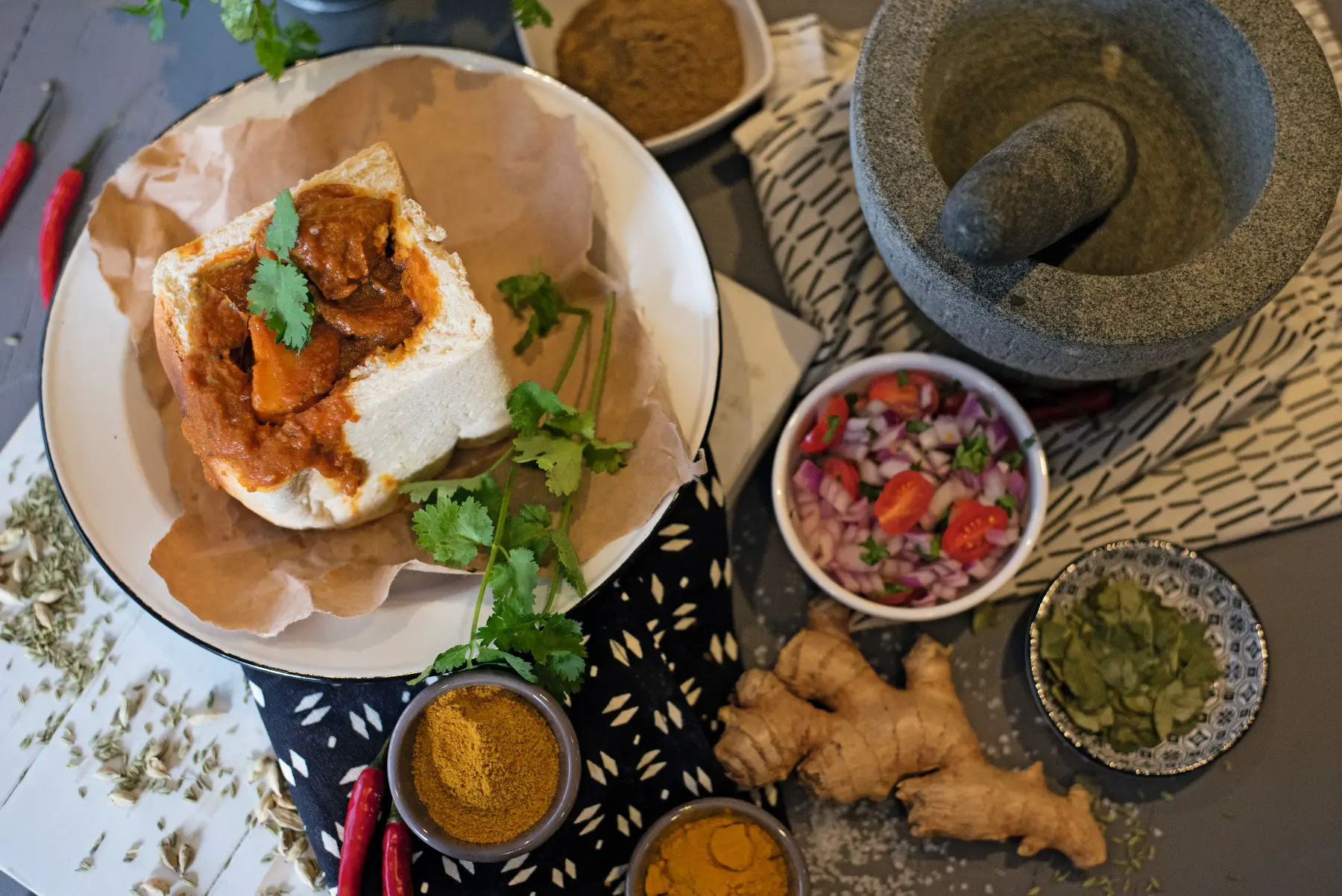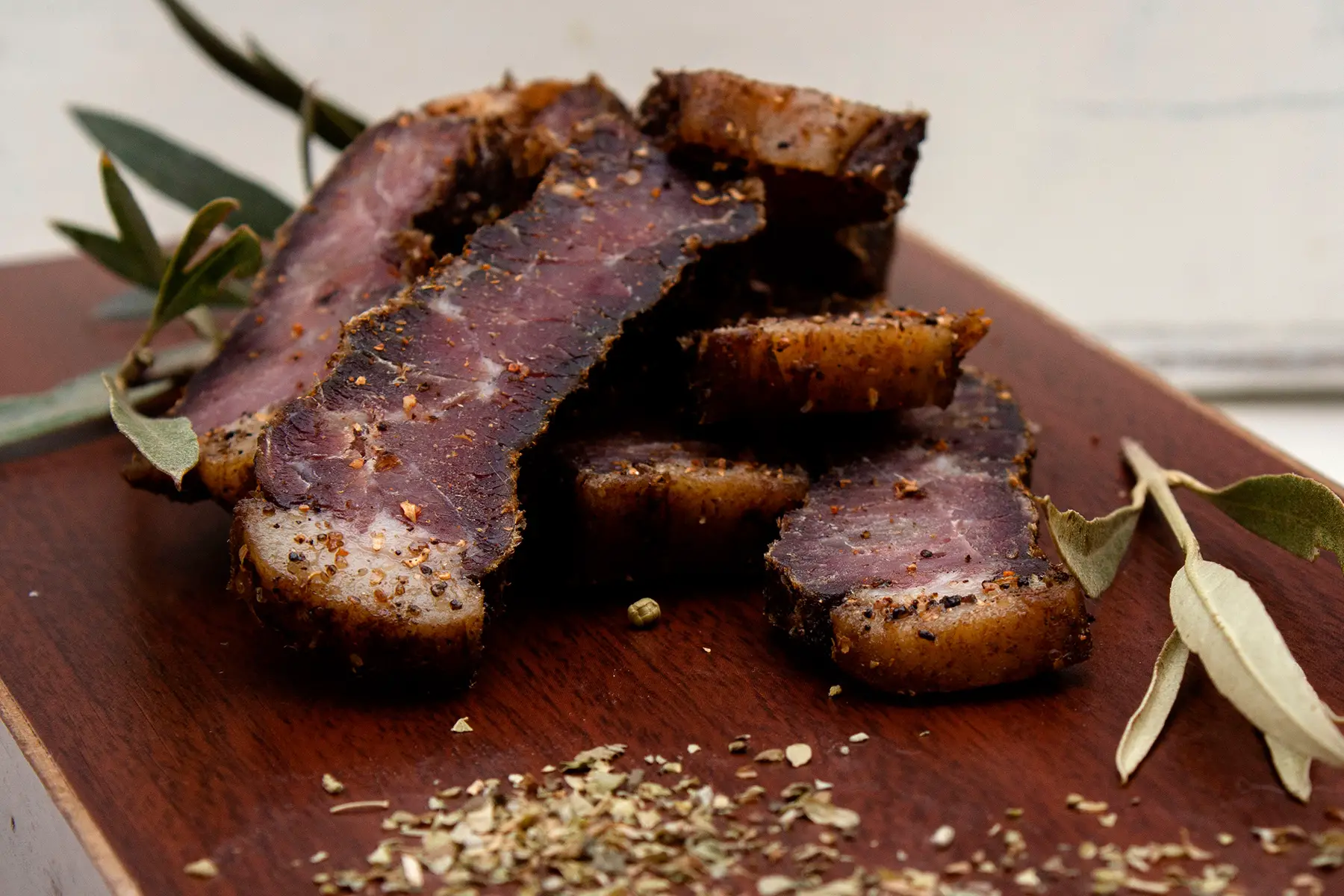South African food is bold and messy, packed with flavor, and will have you go back for seconds (or thirds!). From a fully loaded spatlo to slow-cooked tomato bredie, here are 10 delicious staples worth knowing (and definitely worth trying):
Bobotie
Bobotie may very well be the national dish of South Africa. Imagine spiced minced meat (usually beef or lamb) simmered with onion, garlic, curry powder, and a touch of sweetness (often from raisins or chutney). All of this goes in the oven until ready-baked under a golden, savoury custard topping.
While expats think it sounds strange on paper, you just have to take one bite, and it all makes perfect sense. It’s got layers: sweet, savoury, spiced – but never spicy – and always served with rice, chutney, and maybe sliced banana if your auntie does it properly.
Tracing its history back to 17th-century Indonesian and Dutch influences, bobotie is food from home, the kind that tastes like someone made it just for you, even if you’re eating leftovers cold from the fridge.

Make your own bobotie
- Try this traditional bobotie recipe
- Here’s a recipe for lamb and lentil bobotie
- Give this one-pan bobotie recipe a whirl
Bunny Chow
Despite the name, there’s no rabbit involved in a Bunny Chow. This dish is Durban’s most iconic street food: a hollowed-out loaf of white bread filled to the brim with fiery curry, whether it’s lamb, chicken, beans, or whatever you fancy. What makes this South African food so special is the bread: soft inside, soaking up every drop, and usually quartered unless you’re feeling bold enough for a half or full loaf.
Bunny Chow was born out of necessity during apartheid, when Indian South Africans needed a portable, no-fuss way to serve food to those who weren’t allowed to dine in. It quickly became a symbol of resistance, resourcefulness, and just really good curry.
Today, this dish is eaten by everyone, everywhere, from late-night takeaways to office lunch breaks. It’s messy, it’s glorious, and it has absolutely no patience for cutlery. You eat it with your hands, ideally while sitting on a pavement somewhere, elbow-deep in sauce, wondering why you ever bothered with plates.

Make your own Bunny Chow
- Follow this step-by-step photo Bunny Chow recipe so you can’t go wrong
- Try your hand at this authentic Durban Chow recipe
- Why not try this recipe with shrimp
- Vegetarians will love this Bunny Chow with sweet potato and chickpeas
Spatlo
Also called a Kota (short for “quarter loaf”), this township classic is what happens when the curry is gone and you’ve still got a quarter loaf of white bread left.
Basically, you take your bread, hollow it out, and fill it with… well, everything, really. Slap chips, polony, fried egg, Russian sausage, cheese, atchar (pickled mango), and more sauce than any napkin can handle. It’s a full meal in one hand (though you’ll probably need both).
A fast food icon with zero pretense and maximum attitude, Spatlo is cheap, filling, and brilliantly chaotic. There’s no fixed recipe, no delicate plating, just layers of flavor and carbs engineered to hit the spot… And cure any hangover.

Make your own Spatlo/Kota
- Tune in to this Kota recipe on TikTok
- Try to resist this Spato recipe from the Sandwich Tribunal
- Elevate your plate with this chef-style Kota recipe
Potjiekos
Meaning ‘little pot food’ in Afrikaans, this South African stew is slow-cooked over open flames in a traditional three-legged cast-iron pot. It’s then built layer by layer with the kind of care usually reserved for DIY projects or family feuds. Meat goes in first (usually oxtail, lamb, or beef), then vegetables, more vegetables, and a few secret ingredients depending on who’s cooking.
The golden rule? No stirring. Ever.
Potjiekos is the food of long weekends and even longer stories. Born from Dutch settler traditions and shaped by South Africa’s diverse communities, potjiekos is all about taking it slow – literally and socially. You don’t just make it; you gather around it. People bring drinks, debates, and unsolicited cooking advice. Hours pass, appetites build, and eventually, when the pot says so (not the cook), everyone eats.
No two potjies are alike, and that’s exactly the point. Some come with a rich gravy, others lean spicy or sweet. But whether you’re at a braai, a camping site, or someone’s backyard, potjiekos is less about what’s in the pot and more about who’s around it.

Make your own Potjiekos
- You can find lots of different recipes for Potjiekos here
- Try your hand at this gluten-free Potjiekos recipe
- No one can resist this melt-in-your-mouth Potjie recipe
Mala Mogodu
As South Africa’s most proudly divisive food dish, Mala Mogodu is not for the faint of heart, nor the faint of stomach. For many, it’s a nostalgic delicacy that’s been proudly passed down through generations. For others, an acquired taste that never quite gets acquired.
A combination of mala (intestines) and mogodu (tripe), this traditional slow-cooked stew is made from the parts of the animal that most supermarkets politely (or wastefully) ignore. Prepared with onions, tomatoes, spices, and a good dose of patience, Mala Mogodu is often served with ujeqe (steamed bread), dumplings, new potatoes, fried onions, or rice, depending on where you’re from (and how much gravy you’re trying to mop up).

Make your own Mala Mogodu
- Give this gourmet Mala Mogodu recipe a whirl
- Watch how the dish is made on YouTube
- Try your hand at this traditional Mala Mogodu recipe
Tomato Bredie
Tomato Bredie is a South African comfort food with a distinctly Cape Malay soul. Rich, tangy, and deeply satisfying, this dish is made with tender lamb stewed in tomatoes, onions, garlic, and spices like cinnamon and cloves.
Every family has their own version; some are sweeter, some are spicier, and some are barely recognisable from the last one you had. But no matter how it’s made, tomato bredie always shows up with that same quiet confidence. Warm, generous, and guaranteed to fill you with nostalgia, even if you’ve never had it before.

Make your own Tomato Bredie
- Just try to resist this Tomato Bredie recipe (you can’t)
- Here’s a Tomato Bredie recipe with a reluctant vegetarian twist
Cape Malay curry
This South African food dish doesn’t shout, it simmers. Fragrant rather than fiery, Cape Malay curry is known for its gentle warmth, subtle sweetness, and the kind of aroma that tells you dinner is going to be good.
Spiced with cinnamon, clove, ginger, turmeric, and just enough chilli to let you know it’s there, this curry leans into flavor rather than heat. Whether it’s made with chicken, lamb, or beef, it’s rich without being overwhelming, often lifted by sweet notes from raisins, apricots, or a generous spoonful of chutney.
The sweetness might surprise you at first, especially if you’re used to punchier Indian or Thai curries, but it’s all part of the balance. And that gentle tug-of-war between savory and sweet is exactly what keeps you coming back for more.

Make your own Cape Malay curry
- Get cooking with this authentic Cape Malay lamb curry recipe
- You won’t run a-fowl with this chicken curry
- Here’s a curry recipe that uses beef
- Try your hand at this Cape Malay seafood curry
- Vegetarians will love this vegetable curry
Chakalaka
Chakalaka is what happens when vegetables stop being polite and start bringing the heat. This fiery South African food is a bold mix of grated carrots, onions, tomatoes, baked beans, peppers, and as much chilli as you think you can handle. It’s spicy, tangy, and designed to wake up anything on your plate – pap, meat, bread, rice, you name it.
There’s no one right way to make it. Some people add cabbage, others swear by curry powder, and the brave throw in extra fresh chillies just to see who flinches first. But whether it’s homemade or store-bought, served hot or cold, chakalaka is always loud, proud, and never, ever bland.

Make your own Chakalaka
- You’ll love this simple chakalaka recipe
- Give this traditional chakalaka recipe a whirl
Amagwinya
Crispy on the outside, fluffy on the inside, and unapologetically greasy in the best way, Amagwinya are a food staple of any South African township. Cheap, filling, and available on just about every street corner, these golden balls of dough are also known as vetkoek in Afrikaans. They are the perfect comfort food during breakfast, lunch, and sometimes dinner, depending on how your day’s going.
Some people enjoy Amagwinya plain, but most locals will tell you they are best when stuffed. Classic fillings are cheese and polony, curried mince, or sharp, tangy atchar.

Make your own Amagwinya
- Follow this step-by-step Amagwinya photo recipe
- Try your hand at this traditional vetkoek recipe
- Watch this Amagwinya vetkoek recipe on YouTube
Malva pudding
Malva pudding is food at its sweet and sticky best. This baked sponge pudding is made with apricot jam and soaked (drenched!) in a hot cream-based sauce as soon as it’s out of the oven. Soft, syrupy, and unapologetically rich, it’s served warm with custard, cream, or ice cream (or all three if you’re doing it properly).
Malva pudding shows up at Sunday lunches, birthdays, and anywhere people are in the mood to treat themselves a little. It’s sweet, comforting, and quietly waiting to ruin your self-control.

Make your own malva pudding
- Here’s a classic recipe for Malva pudding
- Get cooking with this Malva pudding recipe





